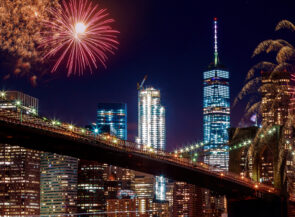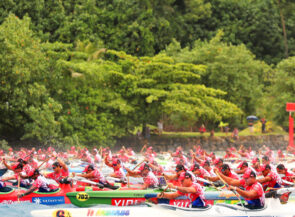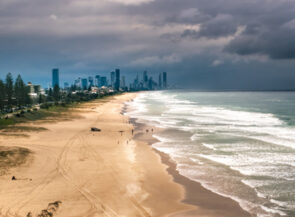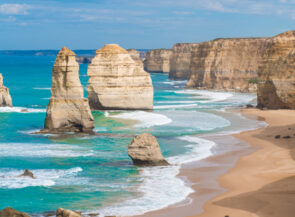Melbourne is often defined in opposition to Sydney. Melburnians will grudgingly acknowledge their Australian rival’s advantages (those beaches, that harbor) before touting their hometown’s cultural bona fides: the acclaimed restaurants, the global sporting events, the ornate architecture. Substance over style, they insist. It’s a similar argument to the one San Franciscans make vis-à-vis Los Angeles, and the resemblance to the Northern California city rings true elsewhere. The capital of Victoria (called Naarm by its Aboriginal inhabitants) owed its modern rise to a gold rush and went on to become a bohemian bayfront city. On top of that, it’s surrounded by world-class vineyards, many of them on the southerly Mornington Peninsula. Despite growing into Australia’s most populous metro area (and undergoing some of the longest pandemic lockdowns on the planet), Melbourne has repeatedly ranked among the world’s most livable cities. Come for a visit, and you, too, might find yourself wanting to call it home.
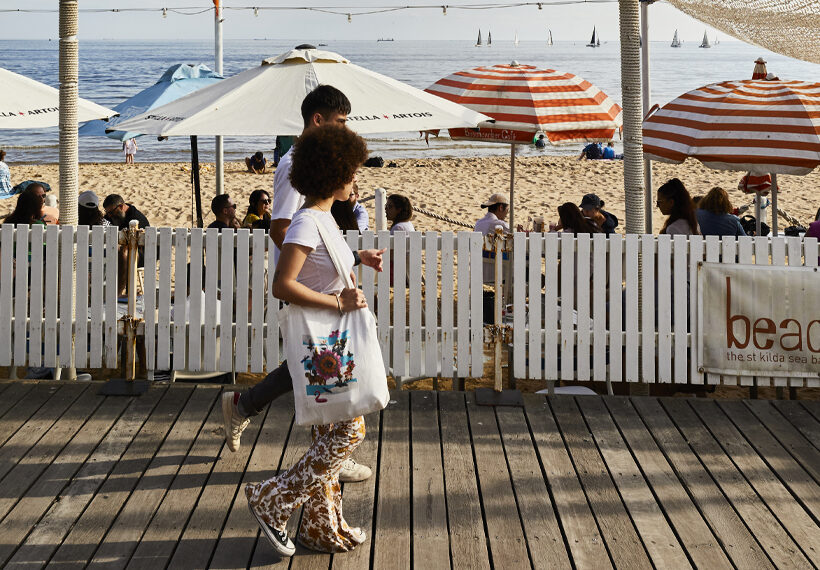
Day 1
A jog in the park, a nap on the beach, and a carnivalesque dinner
One of my favorite ways to explore when I get my feet on the ground in a new city is to literally get my feet on the ground, by going for a run. Fortunately, my hotel, United Places Botanic Gardens, is across the street from the Tan Track, the jogging path that circles the Royal Botanic Gardens Melbourne, on the south bank of the Yarra River. Thanks to jet lag, I’m up with the first rays of the rising sun, so I lace up my sneakers and join the cavalcade of fit Aussies on the track.
About a half mile into my run, I come upon the Shrine of Remembrance, a ziggurat-like monument built to honor Australian soldiers who died during World War I, and then the floral clock, a timepiece presented to the city in 1966 by a group of Swiss watchmakers and laid into a flower bed. Here, I detour from the Tan Track and into the garden, where I pass towering bunya pines, the rainforest–inspired Fern Gully area, and huge, spiky succulents that look as if they landed on this planet with the intention of devouring humankind.
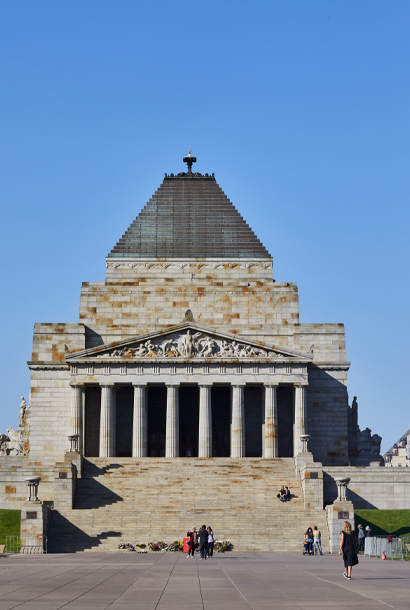
Morning constitutional complete, I rinse off in the rain shower of my suite at United Places and head out for breakfast. A 15-minute walk from the hotel brings me to The Kettle Black, a café that sprawls across a Victorian-era terrace house and the first floor of a neighboring modern tower that looks as if it’s clad in dragon scales. I take a table on the contemporary side and order an avocado toast and a flat white. Melbourne is one of the world’s most caffeinated cities, thanks to a major influx of Greek and Italian immigrants in the 1950s and a third-wave-coffee boom in the early 2000s, and this place illustrates why: After two flat whites that come with cards bearing tasting notes, I feel ready to sprout scaly wings and take flight.
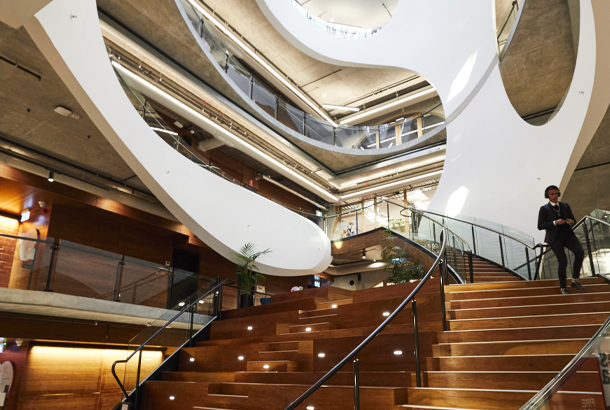
Instead, I walk a block over to St. Kilda Road, where I catch a southbound tram. A 15-minute ride brings me to St. Kilda, a suburb known for its beach boardwalk and boho vibes. The area has long been an LGBTQ+ stronghold, and in 2021 it welcomed the Victorian Pride Centre. I check out the current exhibition, a collection of highly stylized photos of drag queens, and then wander a few blocks over to bustling Acland Street, which is lined with palm trees and funky shops. It’s a dead ringer for Venice Beach—I even hear “Hotel California” echoing from a window somewhere.
Soon I reach the golden sand of St. Kilda Beach. I observe joggers and cyclists sweating their way up the promenade, a few sunbathers soaking up the rays, but few swimmers. A dip of my toes in the water confirms why: It’s freezing, a reminder that directly south across the Bass Strait lies Tasmania, and beyond that nothing but icy ocean until Antarctica.
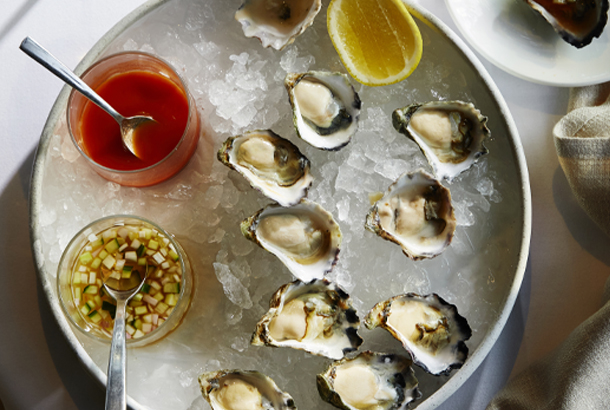
The chill seems to have jolted my stomach awake. Good thing I have a lunch reservation at Stokehouse, a beachfront institution that burned down in 2014 and was rebuilt in a sleek style using sustainable materials a couple of years later. I score a table with a beach view, and the sommelier, Will, pours me a surprising Victorian dry sherry to start. “It goes great with oysters,” he tells me, so I order a plate of them, from Western Australia, with a house-fermented hot sauce. They’re perhaps the best bivalves I’ve ever tasted—small, briny, incredibly creamy—and I follow them up with a coral trout crudo and a butterflied rock lobster from Queensland, which pairs perfectly with a Yarra Valley chardonnay.
I attempt to burn off lunch with a stroll up and down the promenade. First I stop in at Luna Park, a Coney Island–style amusement park that opened in 1912. I pass through the gaping clown’s mouth at the entrance and consider the various rides, but there are, um, a lot of screaming children here, so it’s back to the tranquility of the beach for me.
I meander back up the boardwalk, stopping to appreciate The Wonderful Two, a statue that imagines the world’s last remaining pair of northern white rhinos as conjoined twins. Between the big meal and the walking and the sun, I find myself getting sleepy. If only there were some sort of soft, grainy, welcoming surface nearby…
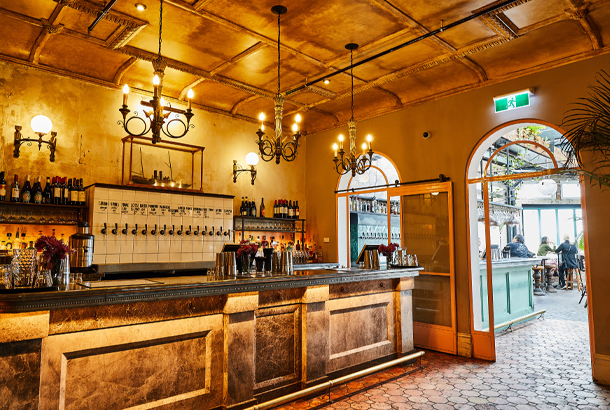
Sometime later I wake up on the beach, shake the sand from my clothes, and cross the road to the 145-year-old Hotel Esplanade. “The Espy,” as locals call it, houses several dining outlets and music venues (including the Gershwin Room, which dates to the 1920s), and it’s also a great place to catch the sunset, thanks to its perch on the bluff above Port Phillip Bay. I order a Carlton draught at the Main Bar and watch as the sinking sun turns the sky into a bright swirl of orange and pink. Bruce Springsteen’s “I’m on Fire” comes on the stereo, as if the gods programmed a playlist to match the colors.
The stars are twinkling above by the time I hop into a cab for the nearby suburb of Ripponlea, where I’ll be sampling the fare from one of Australia’s brightest culinary stars, Ben Shewry, at Attica. This place has been a fixture on the World’s 50 Best Restaurants list for more than a decade, but that’s not what tells me I’m going to love it; rather, it’s the painting of Allen Iverson on the wall and the soundtrack that flits from Ice Cube to Gillian Welch that have me convinced. That’s not it for the Americana, either: Halfway through the meal, my server, Sophie, tells me to stand and leads me through the pastry kitchen and into the backyard, which is dressed up as a faux carnival ground, complete with a rigged bowling pin game, slushies, and corn dogs.
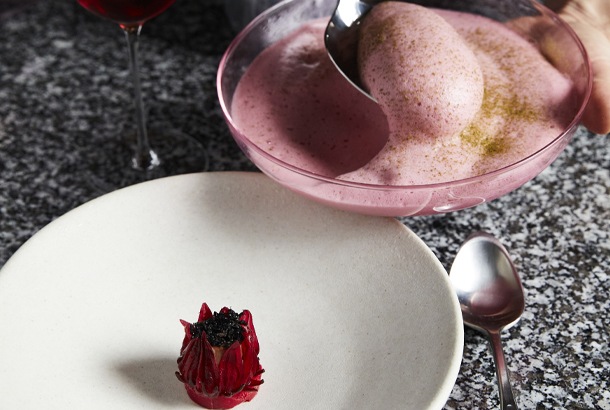
Those corn dogs, by the way, are made from wallaby, which gets at the heart of the tasting menu here. The dishes take full advantage of native ingredients, from barbecued saltwater crocodile ribs (“I’m going to take a picture to show our rabbi!” exclaims the Israeli guy at the table next to mine) to grilled Western Australian marron (crayfish) to an edible hibiscus flower stuffed with emu-liver pâté. “Get excited,” Sophie tells me before delivering the coup-de-grace: a Ferrari-red display cart full of petit fours, including a negroni jelly and a chocolate skull. By the end of the three-hour meal, I’m ready to make like Al Pacino in Dog Day Afternoon: “Attica! Attica!”
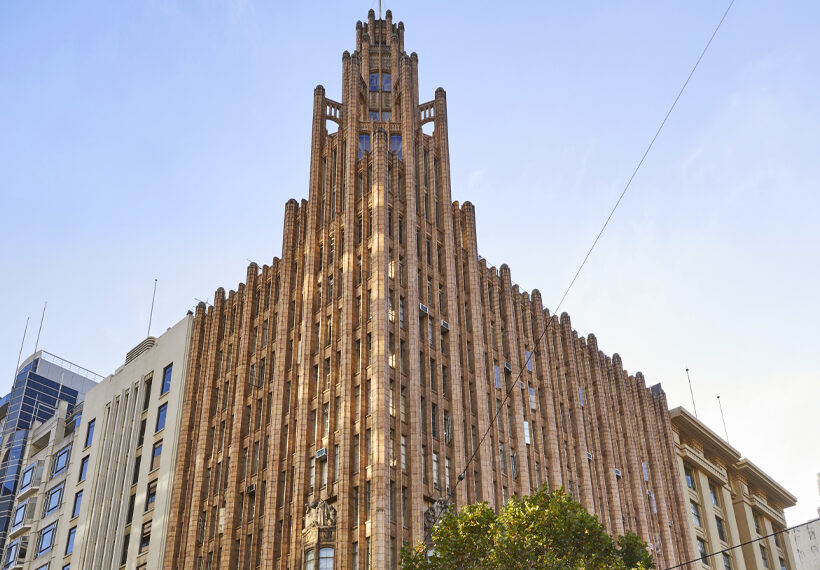
Day 2
Bon Scott, boomerangs, and a big footy match
After dropping my bags in the Central Business District, at Le Méridien Melbourne, I stroll over to what strikes me as a great place to grab a bite (or five): the Queen Victoria Market. Established in 1878, the market sprawls across 17 acres, with 600 stalls that range from butchers and fishmongers to purveyors of prepared foods and keepsakes. I graze my way through kangaroo sausage at The Chicken Pantry, dolmas at Hellenic Deli, local blue cheese at Curds & Whey, and a super-sweet Royal Gala apple at Queen’s Harvest. It’s a true buffet of everything Victoria has to offer.
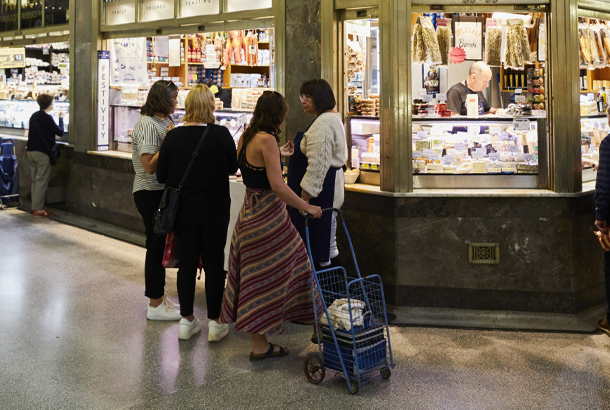
Having buffeted my stomach, I wander back through the CBD. Melbourne is renowned for its Art Deco architecture and its graffiti-coated laneways (that’s Aussie for “alleys”), and I take in a few examples of each. The terra-cotta facade of the neo-Romanesque Majorca Building is framed by pedestrian-choked Flinders Lane. The Manchester Unity Building, inspired by Chicago’s Tribune Tower, rises from Swanston Street, where in 1976 a flatbed truck rolled along carrying AC/DC for a music video for “It’s a Long Way to the Top (If You Wanna Rock ’n’ Roll).” Speaking of Australia’s hardest-rocking band, I also stroll down AC/DC Lane, which is slathered in spray paint and punctuated by a sculpture of legendary frontman Bon Scott.
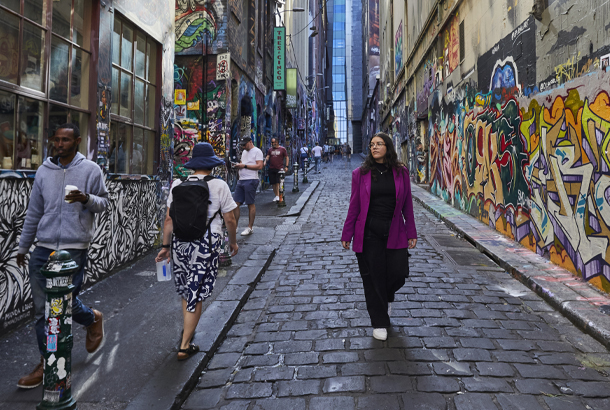
Just a couple of blocks away is Federation Square. The plaza was built to commemorate the centennial of the 1901 federation of Australia, but this site along the Yarra River had been populated by the Wurundjeri Woiwurrung and Boonwurrung people for as many as 40,000 years prior. It’s now home to several museums, including the Koorie Heritage Trust, which is dedicated to Victoria’s indigenous people. Inside, I peruse an exhibit of ornate possum-skin cloaks and then meet Lucas, an educator who looks like a ’90s punk-rock kid—blue hair, painted fingernails, chains on his jeans—but traces his heritage to the Wotjobaluk and Gunaikurnai people. He explains a few facets of Aboriginal culture, my favorite being their hunting techniques. Hunters, it turns out, used the wangim (or boomerang) in very creative ways.
“They would cover themselves in emu dung, bend over, and hold up the wangim to look like an emu head,” Lucas says, doubling over and holding up the tool to illustrate. “Emus are curious, and they’re not very smart, so they’d come over to check them out, and all you had to do was turn around and…” he mimes a whack. “It was, unfortunately for them, the first instance of catfishing.”
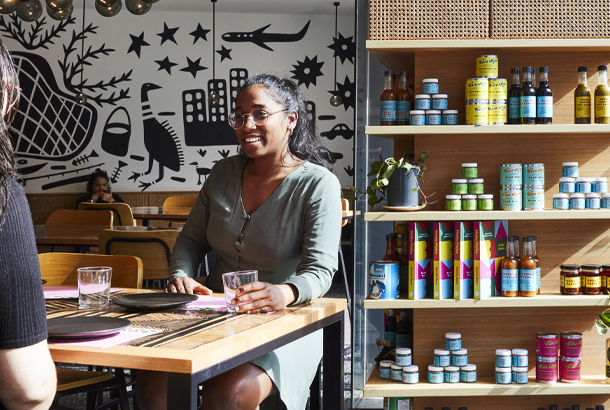
I’ve got an appetite to continue learning about indigenous culture, which I can do right next door at Big Esso, a restaurant that specializes in Torres Strait Islander food. I try namas (coconut-cured kingfish) and saltbush and pepperberry fried crocodile, and afterward I buy a jar of pepperberries to bring home.
Having gained a better understanding of the area’s original residents, I decide to see where today’s hip kids are hanging out. Raph Karanikos, an artist who moonlights as a tour guide for Localing Private Experiences, has told me to meet him in the inner-city suburb of Collingwood, a short tram ride from the CBD, at Aunty Peg’s. This coffee shop is a veritable Temple of Joe, with nary a drop of milk to be found. I order an espresso made from beans grown in El Salvador; it’s tropical, fruity, unlike any coffee I’ve tasted before.
Freshly caffeinated, we hop in Karanikos’s car and drive into the neighboring suburb of Fitzroy. Once a working-class area—my guide’s grandparents settled here when they arrived from Greece and Italy—it’s now Melbourne’s hottest neighborhood. Karanikos points out 19th-century miners’ shacks that now sell for north of $1 million before we stop at Lune Croissanterie, where Kate Reid, a former engineer with Formula 1’s Williams Racing team, makes what some consider the best croissants in the world. (I try a flakily perfect almond one, which, with its protruding nut slivers, reminds me of a stegosaurus.)
Next, we pop by Everfresh Studio, where one of the 14 resident street artists, Ling, shows us a few portraits he’s working on. He started out as a graffiti writer around 20 years ago, and I ask him why Melbourne turned into a mural mecca. “There’s the laneways, so there’s lots of space,” he replies. “In the early 2000s, when the street art explosion happened, you had the internet as well, so people could talk more internationally and pick up on these movements, and in the city you had all these places that you could go and do it. The conditions were just right.”
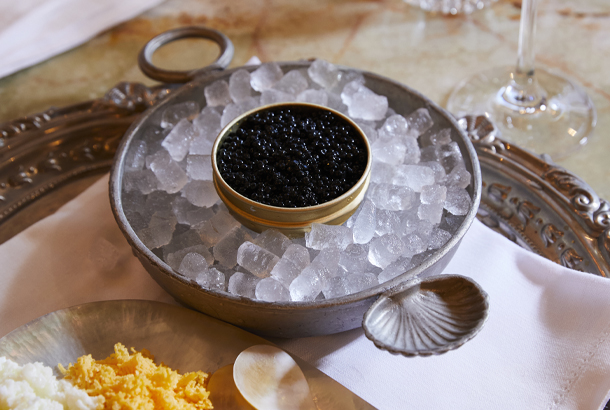
Karanikos drops me off back in the CBD, where I’m having dinner at Gimlet at Cavendish House, an elegant place with a big central bar and an open wood-fired grill in a heritage-listed building that made the World’s 50 Best Restaurants long list last year. I start with an indulgent Lotus Club Sazerac, mixed tableside, then chow down on pipe rigate pasta with blue swimmer crab, followed by strip steak with bone marrow and Bordelaise. As I’m polishing off my meal, chef-owner Andrew McConnell, who bears a passing resemblance to Paul McCartney, joins me for a drink.
“I always thought Melbourne’s got everything we need,” he tells me, “but this space became available, and I walked in and thought, We don’t have that big-city restaurant. But, more importantly, we don’t have that big-city bar. I want people to drop their bags at the hotel, come over, grab a martini at the bar”—we clink our glasses together—“and explore.”
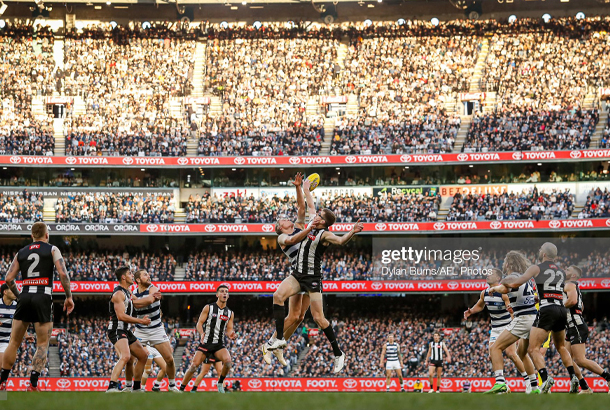
After dinner, I join the horde of people walking along the river toward the Melbourne Cricket Ground. It’s the opening weekend of the Australian rules football season, and tonight’s game of “footy,” as the locals call it, pits last year’s champions, Geelong, against Collingwood (the AFL equivalent of Manchester United, as best I can tell). I’m not really sure what’s happening on the field, except that Collingwood has an American player, a 6-foot-11 Texan named Mason Cox, and every time he does something, a large segment of the crowd of 86,595 chants “USA! USA!” The guy sitting next to me, a Collingwood fan named Steven, turns to me and jokes, “They know you’re here.” At the final whistle—Collingwood wins, 125-103—Steven hands me his program: “So you can say you went to an AFL game.”
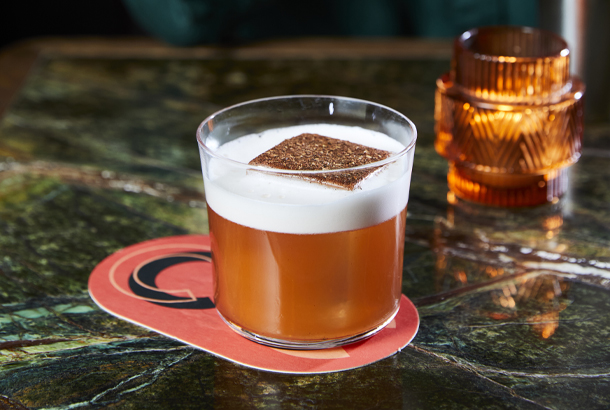
Still buzzing with the energy of the crowd, I go for a nightcap at Caretaker’s Cottage, located in the 109-year-old stone caretaker’s house behind the CBD’s historic Wesley Church. I order an Old Fashioned Cup of Tea (a bourbon punch topped with a black tea bag), and when the bartender finds out I’m from (way) out of town, he grabs a coaster and writes a list of other places I should check out on it. I thank him, but this is my last stop of the night.
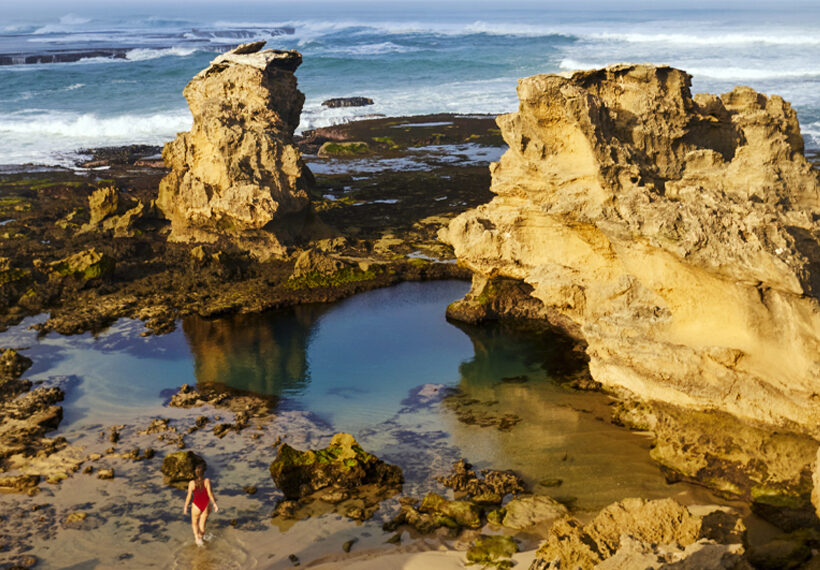
Day 3
A barking owl, an artsy winery, and a rock pool on the Mornington Peninsula
I get a kick-start for what’s going to be a long day at Pellegrini’s Espresso Bar, just down the block from Le Méridien. Opened in 1954 by two Italian immigrant brothers, it’s often credited as the progenitor of Melbourne’s coffee scene, and the cappuccino certainly lives up to the billing.
No trip Down Under is complete until you meet a few bizarre marsupials, and I’m set to do just that at Moonlit Sanctuary Wildlife Conservation Park, about an hour’s drive south of the CBD in a rental car.
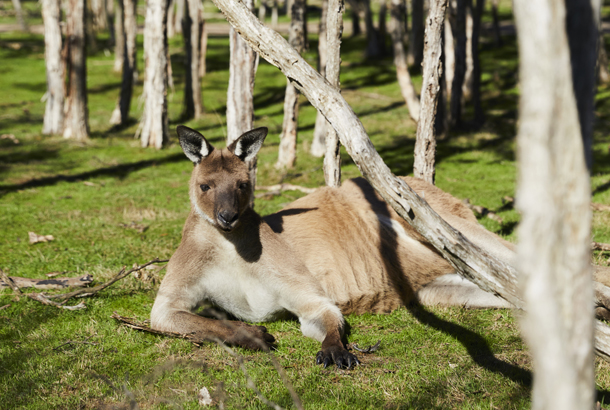
“We really believe when people get close to animals, they form a bond and can continue their own conservation journeys,” marketing manager Michelle Raki says as she leads me to the koala habitat, where I see a few of the cuddly critters napping in eucalyptus trees. (They sleep for up to 20 hours a day.) Then we walk through a wide enclosure where kangaroos and wallabies hop up and eat pellet feed straight from my hands. Finally, we join a few families on benches for the “Conservation in Action” show. Two staffers introduce the audience to a couple of fun animals: a frisky dingo named Sooty and a barking owl named Indi. The owl flies right through the crowd, from one presenter’s leather-gloved hand to the other’s, so close at one point that I feel the wind from his wings on my face. As for the species name—yes, he really does bark like a dog. In the wild, the behavior functions as a territorial signal, but Indi does it to cajole meaty treats from his handlers. I’ll never get over how weird Australian animals are.
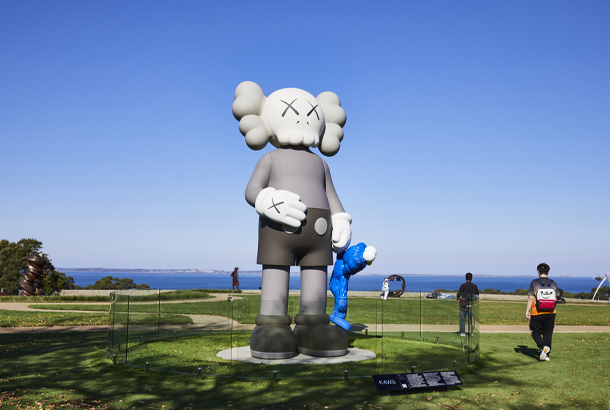
I hop back in the car and continue south. The Mornington Peninsula is known for its cool-climate wines, and I can’t imagine a more glorious setting for sipping than Pt. Leo Estate. Walking from the parking lot, I pass through a giant steel arch and a smooth-walled concrete courtyard decorated with a Queensland bottle tree before entering the glass-walled tasting room, which looks out over vineyards, a sculpture park dotted with around 60 works, and the blue water of Western Port Bay. I take a glass of reserve pinot noir with me and wander the grounds, enjoying the sunshine and the sculptures. My favorites are American artist KAWS’s Share 2020, which looks to me like a demonic vision of Mickey Mouse toting a Grover-like rag doll, and Australian artist Reko Rennie’s Mirri, a geometric pink and black composition that evokes a shield and two boomerangs (er, wangim).
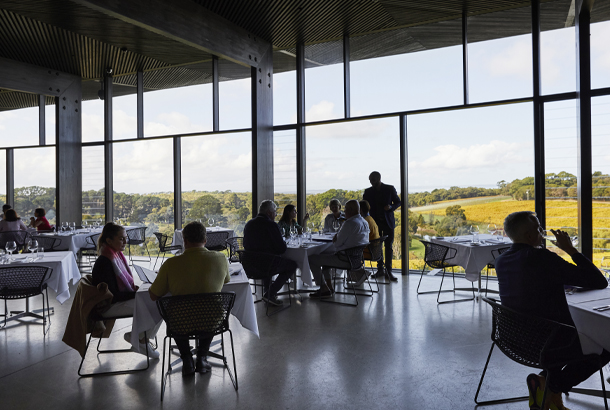
My appetite has awakened, and I figure I might as well have lunch at another architecturally stunning winery with incredible views. Just 10 minutes away is Port Phillip Estate, a hilltop fortress of rammed-earth limestone that stands sentinel over miles of vines and woodland. The only creatures with a better view than the one I have at the on-site restaurant are the wedge-tailed eagles circling high above—but they don’t have access to the oysters, wood-roasted duck, and gamay on my table, do they?
I haven’t been to a beach in almost 48 hours, but Nic Cooper is going to help me remedy that. The proprietor of Wild Adventures Melbourne has told me to meet him at a clifftop trailhead a few minutes away, in Mornington Peninsula National Park. A British expat who fell in love with the natural wonders of Down Under, Cooper leads culturally respectful eco-tours of this lovely part of Victoria. He especially enjoys standup paddleboarding in the bays on either side of the peninsula, but even on my best day I’m equilibrium-challenged, so instead he’s taking me for a swim in his favorite rock pool.
“What I like about this place is that it feels like five countries at once,” Cooper explains as we hike down the trail. “The rocks look like the Bay of Fires in Tasmania, the cliffs feel like Ireland or Scotland, there’s rolling hills kind of like Switzerland, and then this rock pool looks like something from Thailand or Mexico. It’s like something out of a fairy tale.”
Soon we’re hopping across a volcanic-rock beach and over to the pool, carved into a basalt shelf by crashing waves. We strip to our skivvies and leap into the turquoise water. It’s shockingly cold, but as I alternate between diving down to look for marine life and floating on the surface, listening all the while to the surf strike the shore, my shivering gives way to a sense of peaceful wonderment. I can’t believe this place exists—and I can see why Cooper chose to stay here.
Eventually, I remember that hypothermia is a thing and wrench myself from the water. I thank Cooper for the memorable swim and backtrack up the peninsula. Less than half an hour later, I pull up to the 23-foot-tall black sculpture of a jackalope—a mythical half-jackrabbit, half-antelope creature—at the entrance of the Jackalope Hotel. Much like Pt. Leo Estate, the boutique property sets an impressive art collection (Emily Floyd’s aforementioned piece being just one example) on a picturesque vineyard. After checking into my room, I make for the infinity pool. I dive in and rest my arms on the edge, where I watch the golden-hour light glint off the vines. I can’t believe this place exists, either.
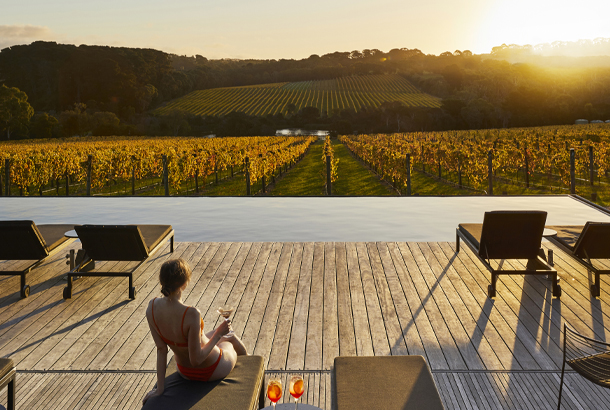
As the sunlight dissipates, a chill takes the air, and I head back to my room to freshen up for dinner at the hotel restaurant, Doot Doot Doot. I know I’m in for an artful meal as soon as I see the dining room, which sits beneath an installation of 10,000 lightbulbs that fade and brighten in slow waves, evoking the fermentation of wine. I work my way through snacks (a kohlrabi dumpling, pickled baby octopus) and starters (stracciatella with cucumber and caviar, golden mussels in foie gras cream) before a main course of grilled snapper and pearl couscous. The courses come with increasingly decadent wine pairings, and by the end I’m not sure if I’m still Down Under or floating somewhere over the moon.
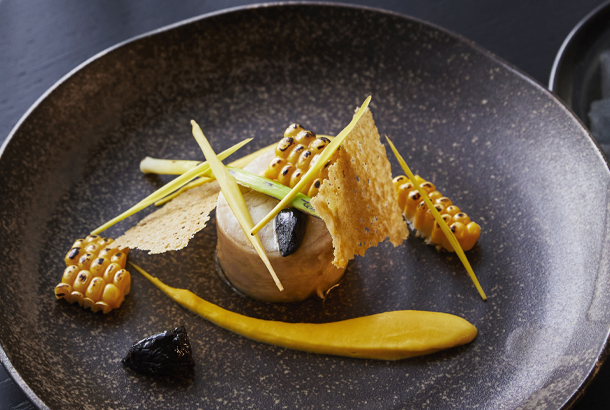
Stuffed, I return to my room, throw on my boxing-style robe, and take a seat on my patio. The pool and vineyard are awash in darkness, but I can still hear them—the water sluicing off the edge, the vines rustling in the wind.
Somewhere beyond them lies the Southern Ocean, and, further on, the end of the world. Strange, isn’t it, how at home I feel out here on the edge?
G’day, Melbourne: United has daily nonstop flights to Melbourne from San Francisco, and starting in October nonstop service from Los Angeles will increase from three times a week to daily.

